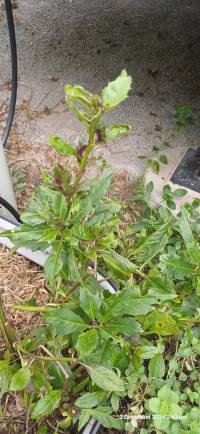This is an old revision of the document!
Okinawan Spinach
Botanical Information
| Botanical Information | |
|---|---|
| Order | Asterales |
| Family | Asteraceae |
| Genus | Gynura |
| Common Name | Okinawan Spinach |
| Species | G. bicolor |
Maturity days
* 10-20 days for rooting cuttings[1]
Planting Months
| Planting months | |||||||||||
|---|---|---|---|---|---|---|---|---|---|---|---|
| Jan | Feb | Mar | Apr | May | Jun | Jul | Aug | Sep | Oct | Nov | Dec |
| X | X | X | X | X | X | X | X | X | X | X | X |
Permaculture uses
| Permaculture uses | ||
|---|---|---|
| Usage 1 | Usage 2 | Usage 3 |
| ground cover | bee food | edible leaves |
Growing condition comments
| Growing Condition | Comment |
|---|---|
| Drought Tolerant | Requires low to moderate levels of water[1] |
| Humidity tolerant | Yes |
| Planting area | Full sun to partial shade[1][3][4] |
| Sunlight | 4-8 hours of indirect sunlight, may suffer sunburn in more than 4 hours of direct sunlight |
Photos
Recipes
Short comments
Perennial green plant, grows in a clump. Leaves are edible (use as a spinach in cooking). Popular in soups, or stir-fry. Minimal pest problems, likes moisture (but is drought hardy).
Propagates via cuttings. Eaten raw, or lightly cooked (goes slimy if overcooked).
General comments
Ecology
Okinawan Spinach is a perennial plant native to Indonesia that prefers warm, wet climates. It forms a dense, low ground cover about 2 feet tall. The plant is relatively pest-free and grows well in subtropical to tropical climates.
Uses
Okinawan Spinach can be used as an edible landscaping plant, ground cover, and ornamental plant due to its attractive two-tone leaves. It's also suitable for container gardening and hanging baskets.
Food
The young leaves and shoot tips are edible and can be used raw in salads, cooked in stir-fries, soups, stews, or steamed. The leaves have a crisp, nutty taste with a faint hint of pine. It's a nutritious vegetable high in vitamin A, vitamin C, protein, fiber, and calcium.
Planting Depth
Cuttings should be planted 2-3 inches deep.
Inoculant
Not typically required.
Seed Saving Tips
Okinawan Spinach rarely produces viable seeds and is commonly propagated from cuttings[1].

